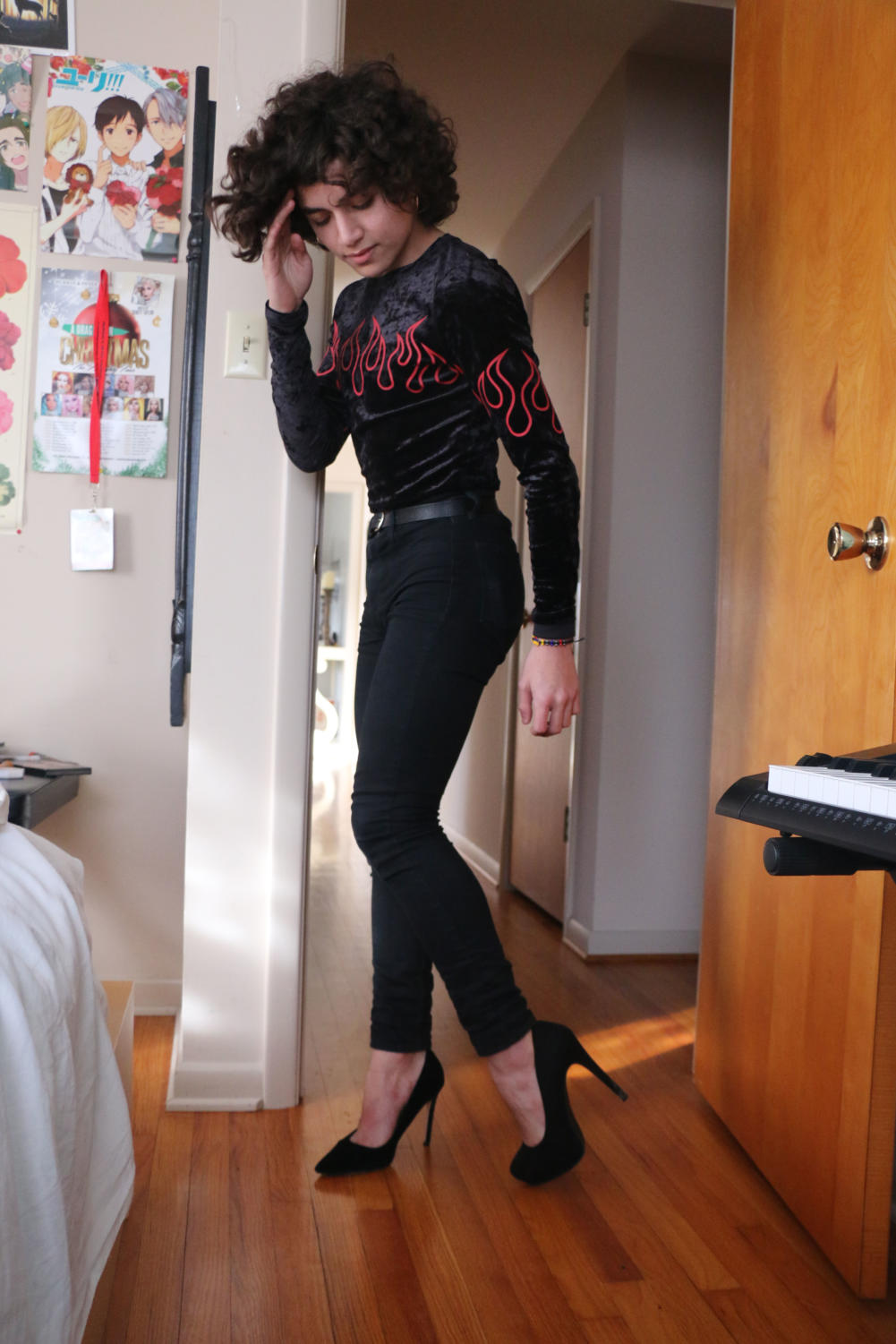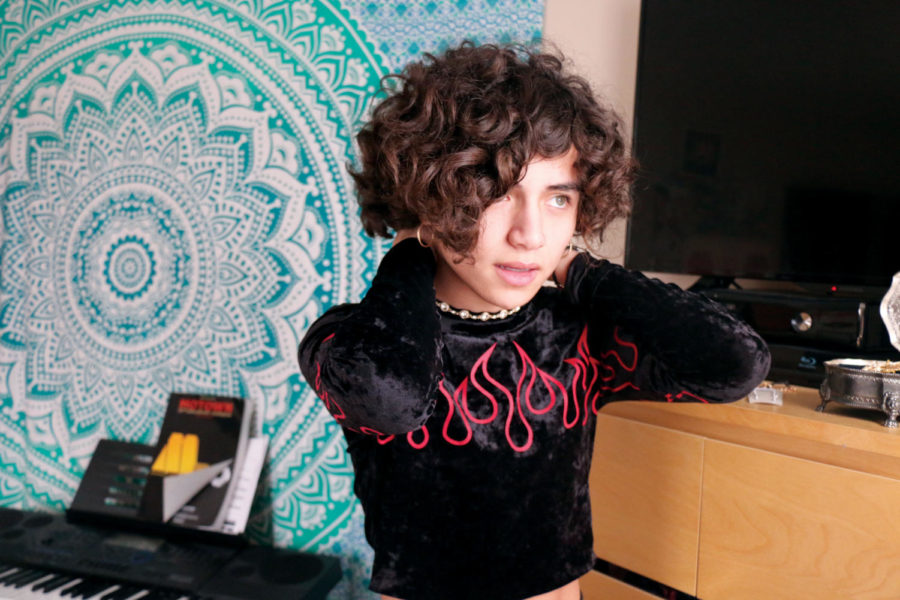All heads turn to him as he walks down the hall. It could be how he holds himself with confidence. Then again, it could be because of the way he dresses. One day, he’s dressed in a turtleneck with heels and statement jewelry, and on the next, it’s a women’s T-shirt with a headband and leggings. Freshman Daniel Tanner said he feels comfortable in both men’s and women’s clothing, and he doesn’t care what pronouns people use for him, as he said, “It’s all the same to me.”
According to Daniel, clothing does not have a designated gender.
He said, “The female silhouette is much more comforting for me,” he said. “Tighter clothes that make me look less boxy makes me more happy. It’s all purely intrinsic motivation.”

Freshman Daniel Tanner poses in his high heels. Daniel said he even wore a dress to homecoming this year and that he was mostly feminine-presenting at the time. He said, “It didn’t even feel like a journey or a movement—it just felt normal. But it did take a lot of courage.”
Daniel said society believes that anything in the women’s section is suggested as “girls only.” However, he said anything can be styled to be more masculine or feminine because in actuality, there is little difference in men and women’s clothing, other than its cut. Women’s clothing is generally more form-fitting, while Daniel said that men’s clothing tends to be looser, creating a “boxy” shape.
But he said his journey hasn’t been easy. When he first started to dress in feminine clothing, “It was not fun,” he said, and he said he sees the same discomfort in other students who are starting to do the same as him. But they are not alone—according to studies by the UCLA Williams Institute of Law, as a teenager takes steps toward presenting themselves as gender non-conforming, there is a 15 percent increase in their chance of being bullied. According to the Centers for Disease Control and Prevention, 34 percent of LGBTQ+ teens have been bullied.
“There’s two sides of the coin; (people) either like it or they don’t,” Daniel said. “There’s the small fraction of people who don’t like it, but they’re too scared to come up to me and say, ‘I don’t like this.’ They say it to other people, not realizing that (I will hear about it) real fast.”
Despite these challenges, Daniel’s mother Karen Tanner said via email that she thinks this school is a safe place for students.
“I do believe (CHS) is a very safe and accepting school,” Mrs. Tanner said via email. “I feel very fortunate to live here and not have to worry about my son being mistreated.”
Daniel agrees and calls CHS a “safe haven” for gender non-conforming students like him and other LGBTQ+ students, especially for those with a strong support group.
“The fact that I do have a strong support group lets me dress like this,” he said. “If I didn’t think that I had a hundred percent support by my friends and people I enjoy, I wouldn’t do what I do, talk how I talk or talk about what I talk about, and stuff like that.”
Social worker James Dowell said the counseling center helps students build that support group so they can be comfortable expressing themselves.
“I think overall, CHS students and staff are pretty supportive,” Dowell said. “I’m sure there are, unfortunately, other incidents, but I think (we should connect students) with the resources they need, whether that’s in the building or outside of it.”
In the end, Daniel said he is supportive of what the school can provide for students like him.
“When it comes to LGBT and gender-nonconforming kids, I feel like Carmel does a really good job, and sometimes people don’t understand that because they compare (CHS) to what they want it to be,” he said. “They really should be comparing it to other high schools where kids are having a lot of bad times.”































![What happened to theater etiquette? [opinion]](https://hilite.org/wp-content/uploads/2025/04/Entertainment-Perspective-Cover-1200x471.jpg)














































![Review: “The Immortal Soul Salvage Yard:” A criminally underrated poetry collection [MUSE]](https://hilite.org/wp-content/uploads/2025/03/71cju6TvqmL._AC_UF10001000_QL80_.jpg)
![Review: "Dog Man" is Unapologetically Chaotic [MUSE]](https://hilite.org/wp-content/uploads/2025/03/dogman-1200x700.jpg)
![Review: "Ne Zha 2": The WeChat family reunion I didn’t know I needed [MUSE]](https://hilite.org/wp-content/uploads/2025/03/unnamed-4.png)
![Review in Print: Maripaz Villar brings a delightfully unique style to the world of WEBTOON [MUSE]](https://hilite.org/wp-content/uploads/2023/12/maripazcover-1200x960.jpg)
![Review: “The Sword of Kaigen” is a masterpiece [MUSE]](https://hilite.org/wp-content/uploads/2023/11/Screenshot-2023-11-26-201051.png)
![Review: Gateron Oil Kings, great linear switches, okay price [MUSE]](https://hilite.org/wp-content/uploads/2023/11/Screenshot-2023-11-26-200553.png)
![Review: “A Haunting in Venice” is a significant improvement from other Agatha Christie adaptations [MUSE]](https://hilite.org/wp-content/uploads/2023/11/e7ee2938a6d422669771bce6d8088521.jpg)
![Review: A Thanksgiving story from elementary school, still just as interesting [MUSE]](https://hilite.org/wp-content/uploads/2023/11/Screenshot-2023-11-26-195514-987x1200.png)
![Review: "When I Fly Towards You", cute, uplifting youth drama [MUSE]](https://hilite.org/wp-content/uploads/2023/09/When-I-Fly-Towards-You-Chinese-drama.png)
![Postcards from Muse: Hawaii Travel Diary [MUSE]](https://hilite.org/wp-content/uploads/2023/09/My-project-1-1200x1200.jpg)
![Review: "Ladybug & Cat Noir: The Movie," departure from original show [MUSE]](https://hilite.org/wp-content/uploads/2023/09/Ladybug__Cat_Noir_-_The_Movie_poster.jpg)
![Review in Print: "Hidden Love" is the cute, uplifting drama everyone needs [MUSE]](https://hilite.org/wp-content/uploads/2023/09/hiddenlovecover-e1693597208225-1030x1200.png)
![Review in Print: "Heartstopper" is the heartwarming queer romance we all need [MUSE]](https://hilite.org/wp-content/uploads/2023/08/museheartstoppercover-1200x654.png)



